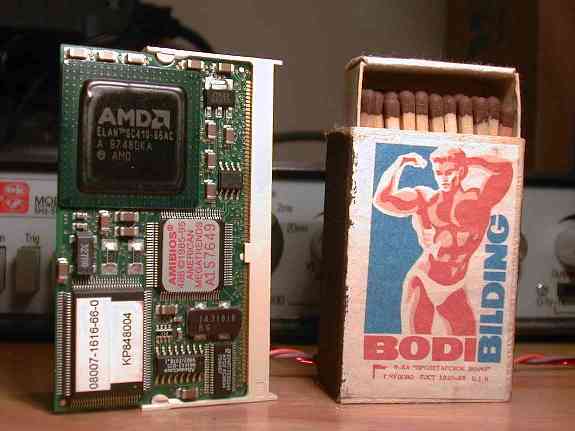
Fifty years ago, a computer with
less computational power than a modern pocket calculator filled a whole
room, and ran programs consisting of
only a few hundred instructions.
In the intervening decades computer hardware has continued to shrink
while computer software has continued to grow, so that today we can fit
the extensive software needed to drive a World Wide Web server into a
computer the size of a box of matches.

The web page you are reading is served to you by the computer in the photo (click on it for a closer look). It is Jumptec's DIMM-PC, a single-board AMD 486-SX computer with a 66 MHz CPU, 16 MB RAM, and 16 MB flash ROM, big enough to hold a useful amount of RedHat 5.2 Linux including the HTTP daemon that runs the web server. At relatively low usage levels it consumes 800 milliwatts from a 5V power supply, rising to 2 watts at 100% CPU usage.
Connection to the internet is via PLIP, a point-to-point network protocol utilizing the Jumptec's parallel port and running at about 27 kilobytes/second. (Both ends of the connection are EPP-capable and a much greater speed is therefore possible, just a Small Matter of Programming.)
Records were made to be broken. The title for the world's smallest web server was previously held by Phar Lap Software. Their computer consists of two PC/104 boards measuring 3.8" by 3.6" by about 1" deep, or about 14 cubic inches.
The contender above, which was up and running on 1/22/99, is only slightly higher and wider than a box of matches but is one third the thickness, measuring 2.7" by 1.7" by .25" for a volume of about a cubic inch, less than a tenth the size of the previous record holder. This record too will fall in due course, let's see how long it takes.
One of the points Phar Lap intended their tiny server to make is that their software is tailor-made for embedded computers, in contrast to general purpose software for general purpose computers.
The point made by our challenger is that technology has narrowed the gap between embedded computers and general purpose computers to where the size advantage of embedded computers has become nonexistent.
The main reason for the vanishing of this difference is that the forces in the general purpose computer market have pushed the technology up and the price points down harder than the corresponding forces in the embedded computer market. We predict that this trend will continue and make general purpose computers more attractive for embedded applications than computers tailor-made for those applications.
Adding to the attractiveness of general purpose computers is the vast quantity and low cost of software available for them. There is much less software for special purpose computers, and it is much more expensive because each such computer has relatively few customers who must therefore shoulder a proportionately greater share of the software development costs.
The matchbox on the right is a Russian collector's item.
--Vaughan Pratt
